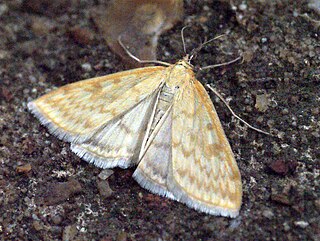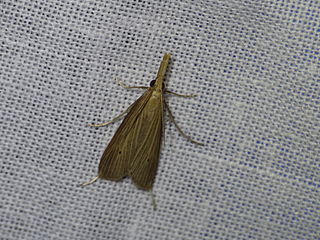
A lunar eclipse occurs when the Moon moves into the Earth's shadow. This can occur only when the Sun, Earth, and Moon are exactly or very closely aligned with Earth between the other two, which can happen only on the night of a full moon when the Moon is near either lunar node. The type and length of a lunar eclipse depend on the Moon's proximity to the lunar node.

The Pyraloidea are a moth superfamily containing about 16,000 described species worldwide, and probably at least as many more remain to be described. They are generally fairly small moths, and as such, they have been traditionally associated with the paraphyletic Microlepidoptera.

Oncocera semirubella is a small moth of the family Pyralidae. It is found in European regions, including the British Isles, and East Asia.

Sitochroa verticalis, common name lesser pearl, is a species of moth of the family Crambidae.
In biological taxonomy, circumscription is the content of a taxon, that is, the delimitation of which subordinate taxa are parts of that taxon. If we determine that species X, Y, and Z belong in Genus A, and species T, U, V, and W belong in Genus B, those are our circumscriptions of those two genera. Another systematist might determine that T, U, V, W, X, Y, and Z all belong in genus A. Agreement on circumscriptions is not governed by the Codes of Zoological or Botanical Nomenclature, and must be reached by scientific consensus.

Sclerocona is a genus of moths of the family Crambidae which contains only one species, Sclerocona acutella. It was first described by the Prussian biologist Eduard Friedrich Eversmann in 1842.

Scopariinae is a subfamily of the lepidopteran family Crambidae. The subfamily was described by Achille Guenée in 1854.

Argyria rufisignella, the mother-of-pearl moth, is a moth in the family Crambidae. It was described by Zeller in 1872. It is found in North America, where it has been recorded from the eastern United States and in the south to Arizona.
Eupoca bifascialis is a moth in the family Crambidae. It is found from southern Mexico to north-central Argentina.
Eupoca sanctalis is a moth in the family Crambidae. It is found from central Costa Rica south to northern Colombia.
Lipocosma nigripictalis is a moth in the family Crambidae. It is found from southern Mexico south to Brazil.
Anania extricalis is a moth in the family Crambidae. It was described by Achille Guenée in 1854. It is found in North America, where it has been recorded from Newfoundland to Florida, west to Texas and Saskatchewan.

Donacaula roscidellus, the brown donacaula moth, is a moth in the family Crambidae. It was described by Harrison Gray Dyar Jr. in 1917. It is found in Mexico (Veracruz) and the United States, where it has been recorded from Florida, Kentucky, Louisiana, Mississippi and Texas.

Lamprosema tampiusalis is a moth in the family Crambidae. It was described by Francis Walker in 1859. It is found on Borneo and in Thailand, Nepal, China, Korea and Japan.
Lamprosema sibirialis is a moth in the family Crambidae. It was described by Pierre Millière in 1879. It is found in Russia, Korea, China and Japan.
Pylartes totuanalis is a moth in the family Crambidae. It was described by Schaus in 1927. It is found in the Philippines (Luzon).
Sedenia xeroscopa is a moth in the family Crambidae. It is found in Australia, where it has been recorded from New South Wales.
Sameodes ulricalis is a moth in the family Crambidae. It is found in the Philippines (Luzon).
Udea poasalis is a moth in the family Crambidae. It was described by Schaus in 1912. It is found in Costa Rica.
Ulopeza conigeralis is a moth in the family Crambidae. It was described by Philipp Christoph Zeller in 1852. It is found in Cameroon, the Republic of the Congo, the Democratic Republic of the Congo, Equatorial Guinea, Ethiopia, Ghana, Ivory Coast, Mali, Nigeria, Sierra Leone, South Africa and Zambia.








